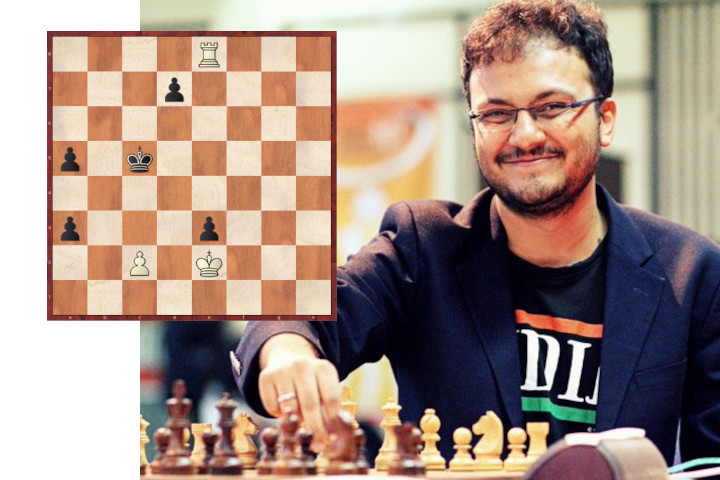


On a Facebook post shared on 2 August 2013, Magnus Carlsen presented an endgame study by V. Katnelson and L. Katnelson. The post was published roughly three months before his first World Championship match.
To tell you the truth, I spent quite a lot of effort on solving this one! My main efforts were made when I was jogging or travelling. The fact that there were just eight pieces on the board meant that it was possible to try to go into complications blindfolded. But the problem was not the number of pieces but the nice interweaving of ideas!
I would ask all those who have not solved this puzzle to not look at the answer before giving it a shot. After all, the depth of the problem can only be understood if you have tried solving it. Otherwise, everything seems just so easy!
Remember that you can try your own variations on our interactive diagrams!
So, the position was white to play and win. Of course, the first move that comes to everyone’s mind is 1.Rxe3. Now 1...Kb4 is forced, and I guess 2.Rb3+ looks the most natural. After 2...Ka4 3.Rb1 a2 4.Ra1 Ka3 5.Kd2 Kb2 6.c4! Ka1 7.Kc1, we reach the following position:
White has stalemated the black king in the corner, and now only pawn moves remain. But Black turns out to be a tricky person to deal with, as he stops the c-pawn right in its tracks with 7...d6!. After this, White just cannot win — 8.Kc2 a4 9.Kc1 a3 10.Kc2 d5 11.cxd5 and now it’s a draw by stalemate.
However, this was a start! Many players think that solving studies means trying to find flashy moves right from the go. I don’t agree — you must always begin with the most natural continuation, and from that variation gain ideas and understand why your move doesn’t work, and then come up with the improved version of the answer. It's like developing an app. You develop an application, then you see the problems and fix the bugs. Then again, you develop the app further and fix the bugs. It’s a continuous process until perfection is achieved.
So, let’s go back to the starting position. We have already learned a few things:
It’s from all these deductions that we come up with the idea of 1.Re4!!
This move cuts off the black king from the fourth rank, and also threatens Ra4. So the only move for Black now is 1...Kb5. Now we push the pawn ahead with 2.c4+, and Black will do well to advance further with 2...Kb4 (2...Kc5 is worse, as now the Black king is behind in the race: 3.Rxe3 Kb4 4.Kd2 a2 5.Re1 Kb3 6.c5! — the key move. 6...Kb2 7.Ra1! and we get close to the game continuation.)
Now that the rook and king are on the same line, we can push the pawn one square ahead with 3.c5+! —then comes 3...Kb3 (3...Kxc5 4.Ra4 Kb5 5.Ra3 Kb4 Ra1 +-) 4.Rxe3+ Kb2 and we reach the critical position of the study.
White has to come up with two consecutive strong moves now. The first one is 5.Kd3!. The main idea behind this move is to keep the second rank free for the rook to give a check. Then 5...a2 and now it’s time for 6.Re2+!!
This was really one of the toughest moves to think about in this study. The idea of the rook check becomes clear once you see it. The rook would like to reach the first rank, but it wants to do it without losing time. Usually, we see such time gaining vertical checks in rook vs pawn endings. Here is a case of horizontal check! After this, White gets two favourable outcomes: he is able to set up a stalemate of the black king, and he has already got his pawn on the fifth rank, i.e. on c5.
After 6...Kb1 (6...Kb3 is similar) 7.Re1+ Kb2, we get the following position:
Maybe for a trained eye, the next move is not so difficult. But nonetheless, it is beautiful!
White plays the nice 8.Ra1!. Black can now push his a-pawn, but it will not change anything. Once the rook is taken with 8...Kxa1, White stalemates the king with 9.Kc2.
Black has 2 ways to play now. One is to push his pawn to a4, and another is to first push his d-pawn. Try to work out up to mate in both variations.
Let’s start with the d5 variation — 9...d5 is met with 10.cxd6! a4 11.d7 a3 12 Kb3! setting up a nice mate via 12...Kb1 13 d8=Q a1=Q 14.Qd1#
A nice mate!
Let’s go back to Black’s ninth move. 9...a4 10.Kc1 a3 11.Kc2 d5, and now taking the pawn will lead to stalemate. Hence, White must play 12.c6 d4 13.c7 d3+ 14.Kd3! Kb2 15.c8=Q a1=Q 16.Qc2#
A beautiful mate. A small detail to notice is that if the pawn were not on a3, it would not have been checkmate!
I am sure those who tried to solve this study found it to be not at all straightforward. It was tough. But the tougher the battle, the sweeter the victory.
| Advertising |